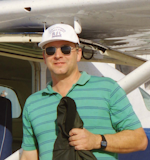On Listening to Wives Tales
A decade ago, I’d been putting up with an ever-so-slightly rough-running Continental IO-520 in my Cessna 206. The first of several IO-520/TSIO-520’s I was to own, the engine met all specs for run-up and ignition timing.
I’d asked a fellow A&P about it and he responded, “Ah, they all sound like that. It’s a Continental six.” I guess I would have left it at that, after all it met required static rpm and sounded a lot like the IO-470 on a Cessna 205 that flew out of our hangar.
Not long afterwards, while researching a Continental Service Bulletin, I ran across one about setting up the Continental fuel control. Seemed like something to do, so I built a gauge set to try it out.
Careful adjustments were accomplished according to the Service Bulletin and the difference in operation was remarkable; the first engine now ran so smooth we got stares as we taxied past others on the flight line. We then tried it on the 205 and found the fuel control wouldn’t adjust into limits; we had the control overhauled and then we set it up. Again, we got a remarkable change in operation.
Soon, we had set up all four TSIO-520’s, the IO-520, and an IO-470. All responded with a very noticeable difference in operation … it’d probably been years since any one of them had been checked. Soon, we had others with Continental sixes coming over to us and we added the pressure check to each 100-hour inspection; it paid off in fuel use and peace of mind.
While performing a drop check of the passenger masks, we found some of the panels not releasing and asked one of the “old” guys what could be done about that. One of the old mechanics explained the check didn’t come out because the fuselage wasn’t expanded. “You see,” he explained, “when you’re at altitude the airplane pressurization causes the fuselage to expand, which loosens up those covers a little and they drop just fine.”
Really? Did anyone explain that to the technical data writer? Of course, it was hogwash and we ended up making the adjustments to get the masks to drop properly.
A fellow A&P was changing out a set of cylinders on an IO-52O and said he did this about every 600 hours on this owner’s plane, I inquired and was told, “You know those 210’s; you can’t get TBO out of the cylinders.”
I had the same engine in my Cessna 206 with 900 hours of flying skydivers and ran it to TBO without changing any cylinders, and the engine that replaced the first one ran to TBO without changing a cylinder. My 402’s, with turbocharged TSIO-520’s, ran to TBO without cylinder issues. After explaining this, it appeared the problem wasn’t the cylinders but the way the pilot was flying the engine and maybe a review of operating habits was in order. Most certainly, it wasn’t “you know those Continental cylinders …”
How about, “You shouldn’t reduce power after takeoff until you’re at 500 feet, because the engine can quit at the first power reduction.” I asked some high-level engineers at Lycoming and Continental if they were familiar with the phenomena. They’d heard about it, but said there was no basis for it.
The Lycoming chief engineer responded the sooner you can reduce power on the engine to cruise-climb, the sooner you reduce chamber pressures on the cylinders; reducing stress on the cylinder hold-down studs/bolts, the entire drive path to the propeller, and reduces temperatures in the entire system. Simply put, use the power you NEED when you NEED it. If you have a 5,000-foot runway ahead of you then reduce power to cruise-climb as soon as you desire.
Getting the airplane configured for better engine cooling and lower stress on the engine components beats hammering everything to 500 feet. Folklore? It seems a trainer in WWII had an engine known for a fuel system that could cause the engine to sputter/quit when brought from full power to cruise power under certain weather conditions.
The bottom line is to embrace the experience of your peers … such things have incredible value to the mechanic. However, there is a reason for technical books and technical representatives from the manufacturer; it pays to put time into these sources to verify those things you’ve been told rather than risk spreading wives tales.



